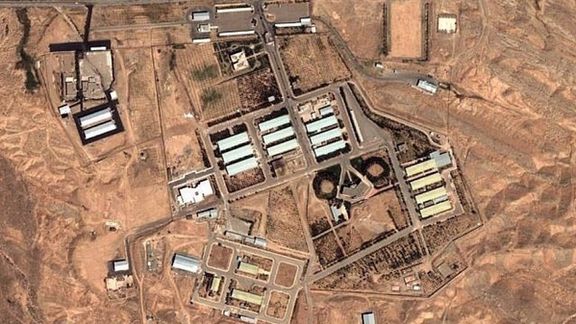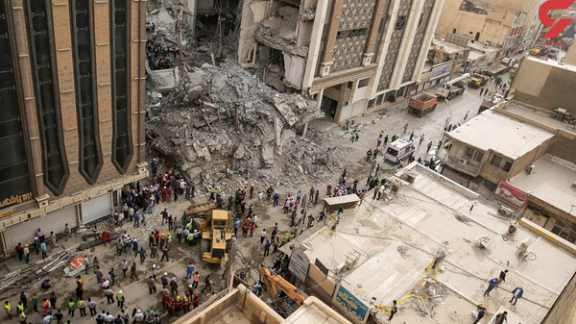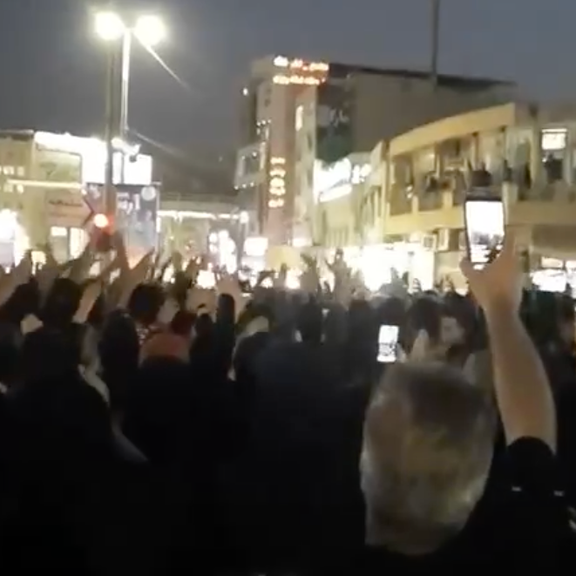Quadcopter Suicide Drones Used In Attack On Iran Military Target - NYT

Suicide drones were used to target an Iranian military research facility on Wednesday, the New York Times reported Friday, citing three Iranian sources and a US official.

Suicide drones were used to target an Iranian military research facility on Wednesday, the New York Times reported Friday, citing three Iranian sources and a US official.
The NYT says its sources believe quadcopter suicide drones were used in the attack. Given the relatively smaller size of these drones it is not clear if they were launched from inside Iran or a forward base near its borders.
Iranian media on Thursday had reported a fire in Parchin military complex, near the capital Tehran, saying that a young engineer was killed at a defense ministry center developing nuclear, missile and drome technologies.
Although no one has taken responsibility, Israel is strongly suspected of conducting multiple sabotage attacks, and possibly drone strikes, against targets in Iran, and even the assassination of its top nuclear operative in November 2020.
Israeli media attributed one particular striketo an Israeli aerial attack, which reportedly destroyed hundreds of drones at an airbase belonging to the Revolutionary Guard in the Iranian province of Kermanshah in February.
Iran has made notable advances in the past few years in producing effective drones that have been widely used by its proxies throughout the region against Saudi Arabia, in Iraq and against a US base in Syria.
Just three days before this attack, an Iranian Qods (Quds) Force colonel was killed outside his home in Tehran by two gunmen on motorcycle. He was reportedly involved in clandestine terror operations against Israel, which has apparently told the United States it was responsible for the killing.

A top Israeli official has denied the country took responsibility for Sunday’s killing of an Iran’s Revolutionary Guard colonel in Tehran, amid fears of Iran targeting Israelis abroad for revenge.
Infuriated by a leak to The New York Times about the assassination of Hassan Sayyad-Khodaei -- a member of IRGC’ Quds Force, responsible for operations outside Iran’s borders – the head of Knesset’s Foreign Affairs and Defense Committee Ram Ben Barak rejected the report on Thursday, saying, “It mainly harms trust.”
The former deputy chief of the Mossad spy agency said, “As far as I know, we did not inform anyone or take responsibility, and that is for the best.”
“We have very many close relationships and a lot of cooperation between us, which all depend on trust, and when it is violated in some way then it damages future cooperation. I hope the Americans investigate the leak and figure out where it came from and why it occurred,” he added.
According to Israeli media, political and security chiefs held consultations after the leak and plan to issue advisories against traveling to some destinations that border the Islamic Republic, including UAE, Bahrain, Azerbaijan, and possibly Turkey.
Saying that Israel was surprised at the leak, an Israeli official told Channel 12 News that there are currently no specific intelligence warnings of attacks but Israelis would be advised to be particularly cautious when visiting those countries due to the presence of terror infrastructures there.
According to The New York Times article, an intelligence official said the Israelis killed Khodaei as a warning to Iran to halt the operations of a covert group within the Quds Force known as Unit 840, tasked with abductions and assassinations of foreigners around the world, including Israeli civilians and officials.

Thousands held anti-government protests Thursday in Abadan where a building collapse Monday has claimed 24 lives so far, and chanted against the Supreme Leader.
Despite the government disrupting Internet connectivity, social media users have posted several videos showing a very large crowd in Abadan chanting slogans against Supreme Leader Ali Khamenei such as “Death to Khamenei”, “Shame on You Khamenei, Leave the Country Alone”, and “Khamenei Is a Murderer, His Rule Is Illegitimate”.
Protesters also chanted against the Revolutionary Guard’s Basij militia telling them to “get lost’ and the state run broadcaster which is accused of biased reporting and censorship of the news related to the collapse of the building.
There are also videos on social media showing protests and mourning rallies in Khorramshahr, a major port city very close to Abadan, Behbahan which is also in Khuzestan Province, Bandar Abbas in Hormozgan Province, and Shahin Shahr in the central Esfahan Province, where many Khuzestani refugees of the Iran-Iraq war (1980-1988) still live.
But Khuzestan is the heart of Iran's oil industry and further unrest could have economic consequences for the government.
Many are angry that in his meeting with lawmakers Wednesday, Khamenei did not express condolences to the families of the victims or mention the tragedy that had happened two days earlier.
In a message Thursday which was read in a meeting chaired by President Ebrahim Raeisi, he called the incident “sorrowful” and called for the rescue operation to be accelerated and the casualty toll minimized, thanked government officials, and extended his condolences to the bereaved families.
“The unfortunate incident in Abadan, in addition to the need for expediting action and the use of all capacities to reduce casualties, which is now of paramount importance, lays the responsibility with all of us — the officials of the country — to pursue the culprits of the incident and to give exemplary punishment to them with the cooperation of the judiciary, as well as to make a concerted effort to prevent its recurrence in all parts of the country,” he said in his message.
But this for many is too little and too late, as they increasingly see the government to be incabable and the ruling elite self-centered.
Videos on social media also show angry protesters on Thursday evening torching the shop of the father of the owner of the building, Hossein Abdolbaghi. Locals are highly skeptical of authorities' claim that Abdolbaghi died in the collapse and accuse them of a cover up. There is also a video showing protesters trying to break the gate of Abadan’s municipality while chanting slogans against Khamenei.
Vice President Mohammad Mokhber and Interior Minister Ahmad Vahidi visited the site Friday morning. The governor of Abadan, Ehsan Abbaspour, told reporters that the death toll has now reached 24. He also warned about the collapse of the rest of the building and urged locals who have refused to leave the site to return to their homes.
Residents fear that authorities may end the rescue operations and say the strong odor rising from the rubble means more bodies are trapped and need to be pulled out.
The global Internet freedom watchdog NetBlocks on Friday confirmed a disruption across Iran with high impact to fixed-line services and said backbone gateway provider Telecommunications Infrastructures Company (TIC) has reported overnight maintenance work in progress at its central datacenters.
Many social media users, however, are suspicious of the timing of the maintenance work and say the disruption was a preventative measure against protesters communicating and spreading the message of protests to the rest of the country.

An official from the Saudi foreign ministry has rejected reports about a possible meeting between Saudi and Iranian foreign ministers, saying nothing has been scheduled for the foreseeable future.
The unnamed official told Reuters that some progress has been made in talks with Teheran but "it's not enough".
He made the comment in reaction to Iranian Foreign Minister Hossein Amir-Abdollahian who said earlier on Thursday that he may meet his Saudi counterpart soon in a third country.
"Iran must build confidence for future cooperation, and there are several issues that can be discussed with Tehran if it has the desire to de-escalate tensions in the region," the official said.
Amir-Abdollahian said at World Economic Forum’s annual meeting in the Swiss city of Davos that the Islamic Republic has made "minimal but good progress" in relations with Saudi Arabia.
The White House said on Thursday that two senior US officials – namely Brett McGurk, Biden's top White House adviser on the Middle East, and Amos Hochstein, the State Department's energy envoy -- visited Saudi Arabia this week for talks that included global energy supplies, Iran and other regional issues.
"I will confirm that Brett McGurk and Amos Hochstein were in the region to follow up on conversations on a range of issues including Iran’s destabilizing activities, ensuring stable global energy supplies and other regional issues," White House press secretary Karine Jean-Pierre said.
Earlier in the week, Saudi Arabia's foreign minister reiterated that there had been some progress in talks with Iran but "not enough" and that the kingdom's hands remain outstretched to Tehran.
Sunni power Saudi Arabia and Shiite Iran, which are locked in proxy conflicts across the Middle East, have held five rounds of talks hosted by Baghdad.

Chaos and confusion are noticeable in Iran’s government-controlled media and among politicians in recent days, as multiple crises have converged to present unprecedented challenges.
One major factor is the Iranian government's haphazard implementation of a policy eliminating food subsidies in a bid to deal with a 50-percent budget deficit. The population pressed by years of hardship took the measure as the ultimate insult and government inability to run the country.
Protests that followed a sudden jump in food prices were dealt with using force, further alienating many people. The last incident portraying the government as corrupt and inept was the collapse of a high-rise building in Abadan that was built by a well-connected insider who ignored construction regulations and mysteriously disappeared after the incident.
Wednesday evening hundreds of Abadan resident came into streets to mourn the victims of the incident but soon began chanting anti-government slogans.
Mehr news agency, which belongs to the Islamic Propagation Organization, a seminary-affiliated office under Supreme Leader Ali Khamenei's direct supervision, pulled a controversial commentary on Thursday, May 26, that said eliminating subsidies, rising prices and "the dissemination of news about widespread corruption even among the Leader's inner circle" have prompted even family members of military and security forces to stand against the government.
Mehr pulled the story after several social media users including prominent journalists such as Reza Haghighatnejad wrote about it in a series of tweets. For a few hours, although the story was pulled, readers could still find it by using search engines and keywords from social media posts. But finally, Mehr, changed the story in a way that all links to the commentary directed readers to an irrelevant story about the availability of wheat.
The commentary said that "the poorly planned and hastily implemented policy of changing the subsidy system has even brought the miliary and police forces among the ranks of dissidents."
The commentary added that "The pilot plan for distribution of subsidized bread has failed because of lack of preparedness and technical capability on the part of the government." The commentary added that "This comes while, the subsidy, which was allocated to bakers has not reached them. At the same time, some officials are demanding that the decision should be reversed."
Mehr added that "Initial estimates indicated the new policy might lead to a 20-60 percent rise in bread prices, but in practice, the price of bread and other goods rose four to six-fold. Some items are even being sold at ten times of their previous price."
The commentary concluded that as a result of the rise in dissent, the regime is getting closer to the abyss on a daily basis." The commentary further suggested that those who have been ruling for more than thirty years should leave the government to others.”
In the Iranian political jargon, any reference to 40 years means from the start of the Islamic revolution in 1979, but references to 30 years, indicate that the author is talking about Khamenei's role as Supreme leader. So, the commentary could be taken as opposition to Khamenei's rule in the circle of Seminarians.
Later on Thursday, Mehr finally acknowledged that the story was on its website and was pulled later, because its website was “hacked by counter-revolutionaries.”

While people in a number of Iranian cities have poured into streets in solidarity with the protesters in Abadan, unconfirmed reports say some other parts of the ramshackle Metropol building have collapsed.
Residents of Khorramshahr and Behbahan, two other cities in the southwestern province of Khuzestan, took to the streets Thursday night, chanting slogans against the Islamic Republic.
The people of Shahinshahr in the central Esfahan province and Bandar Abbas in the southern province of Hormozgan also held protest rallies to show their solidarity with the people of Abadan, whose mourning ceremonies for the victims of the collapsed ten-story Metropol twin towers have turned into anti-government protests since Wednesday.
During the Thursday night protests in Abadan, people chanted slogans against the Supreme Leader Ali Khamenei himself, saying “Khamenei is a murderer; his rule is illegitimate” despite the deployment of anti-riot police.
Iranians see the Metropol incident, with 24 people dead so far, the result of powerful insiders not abiding by laws and regulation and violating building codes, and accuse the authorities of letting Metropol owner flee Iran.

The government says the owner died in the collapse, but protesters say authorities are lying and the well-connected man has fled.
People in Khuzestan, Esfahan and Tehran are reporting serious disruption in their access to the internet amid ongoing protests to prevent uploading images of protests to social media.
Iran witnessed days of protests in May when the government raised food prices, with the overall political situation remaining tense.